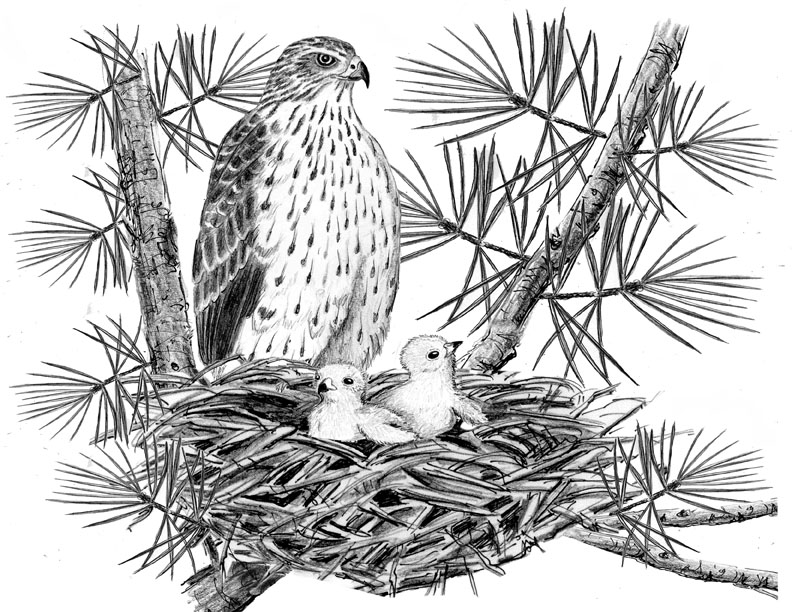
Dear Bird Folks,
There is a pair of hawks hanging around our backyard. We think they are Cooper’s Hawks. We also think they have nest just across the street from our house. Here are a couple of photos. What do you think?
– Debbie, Eastham, MA
Yes, they are, Deb,
Based on your photos, the birds in your backyard are indeed Cooper’s Hawks. However, these hawks are immature. This means they aren’t likely nesting across from your house, or any place else. But just to be sure we are both talking about the same hawk species, I’ll swing by your house after work and have a look. I’ll be the one walking around your yard with a pair of binoculars, so don’t mistakenly sic your dog on me. I don’t climb trees as fast as I used to. Also, how do I get to your house?
Usually when I ask people directions to their homes, they mumble some vague information. They probably don’t believe that I’ll actually show up (or maybe they’re afraid I will). Debbie was different. She grabbed a pen and a piece of paper and began drawing a map to her house, and what a map it was. I don’t know what Debbie does for a living, but if she isn’t a cartographer she should be. Every street, house and tree were drawn perfectly to scale. I could have driven there with my eyes closed, but I didn’t dare try…not with all this summer traffic. That would be dangerous.
When we arrived at Debbie’s house (I had dragged Casey along for a diversion, just in case Debbie really did have a dog) we parked the car, looked up and there was the hawks’ nest, exactly where her map said it would be. It was well hidden near the top of a tall pitch pine. Through the thick branches we could make out the white downy feathers of one or perhaps two chicks. That was cool, but I wanted to meet the parents. Debbie’s photos indicated that the parents were still immature, and thus should not yet be breeding. Something was fishy, or so I thought.
We hung around the nest tree until we heard a hawk calling from a small wooden lot down the street. I began bushwhacking my way into the lot but stopped when Casey pointed to a tree just in front of us. Sitting on a branch and eating a fresh kill was an immature female Cooper’s Hawk. The bird was so focused on her meal that she didn’t seem to care about us. Cooper’s Hawks typically feed on small birds, but this bird had just caught a chipmunk. (Upon reading this section I’ll bet half of the readers are thinking, “poor chippy,” while the other half are wondering how they can get this hawk to come and deal with the chipmunks in their yards. Casey was in the “poor chippy” camp.) I stayed focused on the hawk, because I wanted to see if it would fly to the nest and actually feed the chicks. I didn’t have to wait long.
With its meal about half gone, the hawk finally looked up and realized she was being spied upon. The big bird then lifted off and flew directly to her nest, and began feeding her chicks. I just stood there shaking my head. How was this hawk able to have a family at such a young age? I needed to do some serious research on the topic. In other words, I had to ask someone smarter than me; but a person like that will be hard to find, so this could take a while. In the meantime, I’ll tell you a bit about Cooper’s Hawks.
Cooper’s Hawks, which were named after New York scientist, William Cooper, are medium-sized hawks that specialize in hunting birds (and sometimes, poor chippy). I’ve mentioned this before, but when our birdfeeders suddenly become deserted, a visiting Cooper’s Hawk is often the reason. Like many of us, Cooper’s Hawks are fairly new additions to Cape Cod. As recently as the 1980s they were only rare winter visitors. But since that time the population of these speedy predators has grown rapidly and now they are here year-round. Adult Cooper’s Hawks have dark gray backs and rusty barred chests and bellies. The immature birds are basically brown, with the coloring of a sparrow, a giant, menacing sparrow. During migration they are…wait, I just found out the information I have been looking for, and it’s very exciting. Well, sort of.
Through my many professional connections, I was able to get in touch with Mark Faherty, who is the Science Coordinator at Mass Audubon’s Wellfleet Bay Wildlife Sanctuary and the radio star of WCAI’s Bird News. Mark agreed that it is indeed rare for a pair of immature Cooper’s Hawks to breed. According to his information, only about five percent of all Cooper’s Hawk couples breed during their first year. How about that? This is all so exciting. But I probably shouldn’t be surprised. After all, this is happening in Eastham, a town that has lots of cool things, including their annual Festivus pole and an entire weekend dedicated to a windmill. Yes, a windmill. While ironically, another Cape town is taking their windmills down. Go figure.
Congrats on your young Cooper’s Hawk family, Debbie. They’ll probably hang around for a few more weeks (much to the dismay of your songbirds and those poor chippies). Eventually, they’ll all disperse. But don’t worry; Coops tend to return to the same breeding area year after year. This means your hawks will likely be back next spring. But just to make sure they don’t get lost, better give them one of your maps. Then they’ll be back, guaranteed.